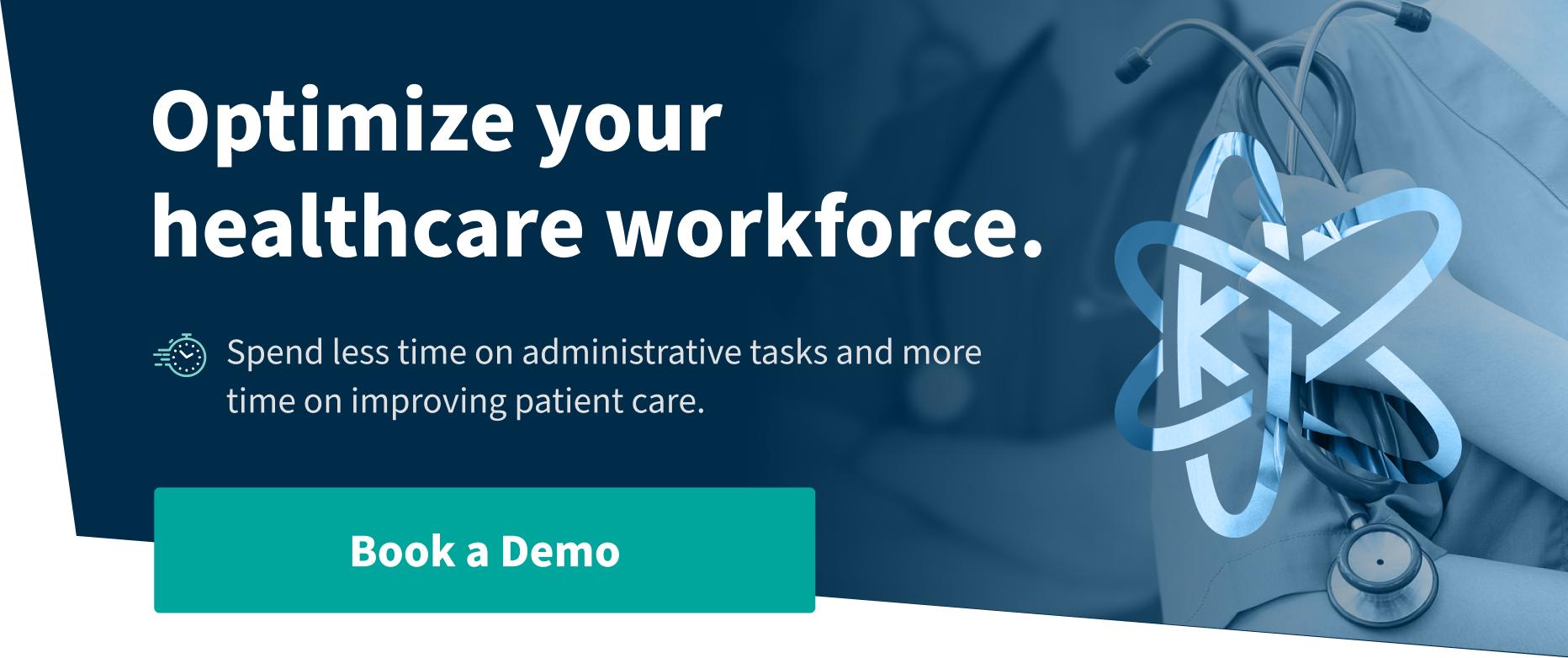If you're a healthcare operations leader managing a growing practice or health system, you know the truth about clinician scheduling: it's never just about scheduling.
Every time you adjust a shift, you're triggering an avalanche of tasks.
Credential verifications need checking. Compensation rates need recalculating. Coverage patterns need reanalysis. What should be a simple matter of putting the right clinician in the right place becomes a complex dance of maintaining operational excellence - especially when you're coordinating a mix of employed, contract, and contingent clinicians across your organization.
In this blog, we'll show you how to turn scheduling headaches into smooth operations. No more juggling spreadsheets, no more late-night panic over coverage gaps, and no more wrestling with disconnected systems.
Scheduling Problems That Cost You Time and Money
Manual Process Problems
Every schedule change requires updating multiple systems. Your team spends hours on basic tasks: updating spreadsheets, sending emails, making phone calls about shift swaps. This manual approach leads to outdated information and scheduling gaps that could affect patient care.
Unbalanced Workloads
Without clear visibility into scheduling patterns, some clinicians end up overworked while others are underutilized. Tracking hours, specialties, and availability manually makes it nearly impossible to distribute work fairly. This imbalance affects both clinician satisfaction and care quality.
Communication Issues
Schedule updates get lost between different communication channels. When changes happen, there's no single source of truth. This leads to confusion about who's on call, delays in finding the right clinician, and potential gaps in coverage - especially during critical situations.
Limited Flexibility
Managing last-minute changes becomes a major challenge. Without an efficient system, finding qualified replacements for unexpected absences takes too much time. Each change requires checking credentials, confirming availability, and updating multiple records manually.
Administrative Complexity
Creating schedules means tracking multiple variables: clinician availability, credentials, shift patterns, pay rates, and coverage requirements. Coordinating these elements across employed, contract, and contingent clinicians creates a heavy administrative burden that increases error risk and reduces efficiency.
How Kimedics Helps You Build Better Schedules, Faster
Automated Schedule Communications
One of the biggest time-drains in healthcare operations is the constant back-and-forth about shifts. Did the clinician see their new schedule? Have they confirmed their shifts? Who needs to know about last-minute changes?
Kimedics transforms this scattered communication into a smooth, automated flow. The moment a schedule change happens, the right people know about it. The system automatically:
- Sends notifications to clinicians about their schedules
- Collects shift confirmations from clinicians
- Alerts managers when shifts are accepted or declined
- Notifies relevant team members about any changes
Think about how much time your scheduling team currently spends just following up on basic schedule communications. With automated notifications and confirmations, they can redirect that time to more valuable tasks - like strategic planning or improving clinician satisfaction.
With the help of Kimedics, one medical group went from managing 300 shifts per month to successfully coordinating 900 shifts, all while reducing the time spent on scheduling tasks.
Real-Time Updates and Mobile Access
Kimedics brings your scheduling system into your clinicians' hands through its mobile app. Every schedule update happens instantly across the platform. Clinicians can check their shifts, pick up open slots, and update their availability directly from their phones - whether they're at home, in transit, or at work.
When urgent coverage needs arise - like a clinician calling in sick before a shift - scheduling managers can immediately post the opening. Available clinicians get notified right away and can claim the shift through the app. This quick response helps maintain consistent coverage and reduces the stress of finding last-minute replacements.
The system ensures everyone sees the same, current schedule at all times. This eliminates the confusion of outdated schedules and helps prevent missed shifts. For healthcare operations leaders, this means less time spent on urgent staffing calls and more confidence in their coverage plans.
Integrated Roster Management for One Source of Truth
The Kimedics scheduler integrates all your provider data into one view. When you're making schedules, you can instantly see:
- Which clinicians are qualified for specific roles
- Current work hours and overtime status
- Up-to-date credential status
- Individual pay rates and cost implications
- Availability based on preferences and time-off requests
No more switching between systems or manually checking multiple databases.
This means you can make quick, informed decisions while staying within budget and compliance requirements. If a clinician's credentials are expiring soon or they're approaching overtime limits, the system alerts you before you assign the shift. This helps prevent scheduling errors that could affect compliance or costs.
Data-Driven Insights For Smart Scheduling Decisions
Kimedics' advanced analytics capabilities transform raw scheduling data into actionable insights. The platform provides real-time data on various metrics such as shift distribution, overtime hours, cost per shift, and more. These insights enable healthcare leaders to optimize their workforce management strategies continually.
For instance, the system can show you:
- Which shifts regularly need overtime coverage
- When certain specialists are being underused
- Where staffing levels don't match patient demand
- Times when you're overstaffed or understaffed
Take an emergency department's staffing pattern: The data might reveal you have too many clinicians during weekday nights but not enough weekend coverage. With these insights, you can adjust your schedules to match real patient needs, control costs, and maintain quality care.
Built-in Rate Management
Think about the complexity of clinician pay. Different shifts carry different rates. Weekend coverage commands premium pay. Holiday hours need special calculations. Contract clinicians have their own payment terms. One small error in tracking these variables can lead to payment headaches and frustrated clinicians.
Kimedics connects your scheduling directly to payroll calculations. When a clinician works a night shift, weekend rotation, or holiday coverage, the system automatically applies the correct pay rate. It knows which shifts qualify for premium pay, tracks overtime hours, and accounts for different contract terms. This means:
- No more manual calculations of complex pay rates
- Accurate payments for every type of shift
- Clear tracking of overtime and premium hours
- Automatic handling of different contract terms
- Fewer payment disputes and corrections
For healthcare operations leaders, this integration eliminates the constant cross-checking between scheduling and payroll systems. Your finance team spends less time fixing payment errors, and your clinicians get the confidence of knowing their unique scheduling arrangements will be reflected correctly in their pay.
Custom Shift Templates
Creating schedules for healthcare facilities isn't as simple as filling empty slots. Each shift needs the right mix of skills, credentials, and privileges. An emergency department night shift requires different qualifications than a routine clinic day. Making sure you have properly credentialed clinicians for each role is crucial for both patient care and compliance.
Kimedics lets you build shift templates that automatically match the right clinicians to the right roles. Set up your requirements once, and the system helps maintain compliance every time you schedule. For example:
- Define exactly what credentials are needed for each shift type
- Specify required privileges for specialized units
- Set minimum experience levels for certain roles
- Create templates for different departments or facilities
When you're scheduling, the system automatically shows you only clinicians who meet these requirements. This prevents scheduling errors before they happen, protecting both your organization and your patients. No more last-minute scrambles when you discover a clinician isn't properly credentialed for a particular shift.
Transform Your Scheduling Operations Today
Your clinical team deserves a scheduling system that works as hard as they do. Whether you're managing a growing practice or overseeing a large health system, the ability to schedule efficiently directly impacts both operational success and clinician satisfaction.
Ready to see how Kimedics can transform your scheduling operations? Our team understands the unique challenges of healthcare workforce management. Schedule a consultation today, and let's discuss how we can help you build better schedules, faster.


